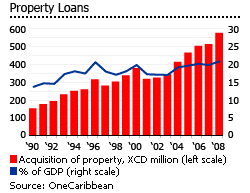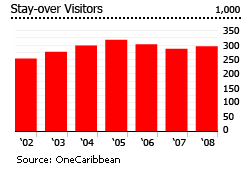Harsh times for St. Lucia’s property market
St Lucia’s property market slowed in early 2009, as the impact of the global crisis spread to this small tourism-dependent island.
The slight fall in house prices was mainly caused by the drop in the value of the British pound against the US dollar, according to local real estate agents, causing demand from British homebuyers to weaken.
The Eastern Caribbean dollar (XCD), the official currency in St Lucia, is pegged to the US dollar at XCD2.7 = USD1.
Despite this, St Lucia’s property market has fared better than most Caribbean islands. St Lucia is still seen by rich holidaymakers as one of the best places to invest, as property prices in the island are about 40% to 60% lower than Barbados.
"The only price softening that has taken place (in St Lucia’s property market) has been reflective of the pound weakening against the dollar. Sellers have been willing to bend prices a bit for British buyers to reflect this currency shift," says Tourism Minister Allen Chastanet.
Some local real estate agents claim that property values have risen by about 10% to 15% annually in the past few years. However, in the absence of official house price statistics, these claims are hard to verify.
The northern coast, where most residential developments are concentrated, saw the highest house price rises in the past several years.
Residential developments
In March 2009, property prices ranged from XC$5,940 (US$2,200) to XC$9,180 (US$3,400) per square metre (sq. m) for houses with sizes from 150 sq. m to 400 sq. m., according to Global Property Guide research. Condominiums had higher prices, surprisingly, at XC$11,340 (US$4,200) per sq. m.
- A typical 150 sq. m. house cost XC$877,500 (US$325,000)
- A typical 400 sq. m. house cost XC$3.51 million (US1.3 million)
- A typical 170 sq. m. condominium unit cost XC$1.94 million (US$720,000)
Most new developments in St Lucia are in the island’s north, including the capital city Castries, and Rodney Bay. Southern coast development is limited by strict planning laws, and by the area’s dense rainforest.
- The Landings – St Lucia’s first residential private yacht harbor. Prices range from XC$1.49 million (US$550,000) for one-bedroom houses and XC$2 million (US$750,000) for two bedroom houses. The Landings is in Rodney Bay, on St Lucia’s north west.
- The Seaside – A luxurious gated community on the Cap Estate coastline. Prices of oceanfront residences start at around XC$2.46 million (US$904,000).
- Allamanda – A prime development located in Anse Galet, the northernmost tip of St Lucia. Two-bedroom apartments start from XC$2 million (US$755,000). Three-bedroom townhouses are sold for XC$2.36 million (US$875,000) and villa plots for XC$1.15 million (US$425,000).
- Cotton Bay Resort – One-bedroom flats are priced at XC$783,000 (US$290,000). Prices for two-bedroom villas range between XC$972,000 (US$360,000) and XC$1.22 million (US$450,000).
- The Island Sanctuary, Marquis Estate – Located in the northeastern coast, property prices range from XC$488,000 (US$180,700) for studio suites to XC$4.2 million (US$1.56 million) for two-bedroom spa villas.
- The Tides Sugar Beach – An exclusive residential community located in the magnificent Val de Pitons, a UNESCO World Heritage Site. Property prices range from XC$1.9 million (US$705,000) for one-bedroom villas to XC$4.05 million (US$1.5 million) for two-bedroom super deluxe villas. Due for completion in 2011.
Sluggish mortgage market

Residential properties are usually paid in cash and in foreign currency (US dollars). St Lucia’s mortgage market has grown little during the past decade. From 18% of St Lucia’s GDP in 1997, the mortgage market grew to about 20.8% of GDP in 2008.
Mortgage interest rates in St Lucia are about 2.75% above US LIBOR. The maximum loan to value (LTV) ratio varies between 60% and 70%, with term periods from 15 years to 25 years.
About 55% of the outstanding property loans are used for house and land purchases, while the remaining 45% are used for home construction and renovation.
Small long-term rental market

The supply of long-term private rental properties in St Lucia is limited, as most landlords prefer to rent to short-term vacationers. Rental properties are concentrated on the northwestern coast, especially in Castries.
Rents for two-bedroom houses in St. Lucia range from XC$2,700 (US$1,000) to XC$5,130 (US$1,900) per month. Three-bedroom houses rent from XC$5,940 (US$2,200) to XC$10,800 (US$4,000) per month.
In March 2009, Global Property Guide research showed that condominiums produce an average gross rental yield of 4.18%. The northern coast has higher rental yields because of numerous tourist and residential developments, attractive beaches, and leisure amenities.
Rental occupancy rates were about 67.8% in the whole island. The rental occupancy rate on small properties is higher, at around 70.3%.
The economy slows

From average annual GDP growth of 4.2% from 2003 to 2006, economic growth slowed to about 1.7% in 2007 to 2008.
The economic slowdown was mainly due to a drop in construction activity. Construction dropped by 10.3% in 2007 and by another 14.4% in 2008. The construction sector grew rapidly in 2005 and 2006, due to an increase in tourism developments, and a road rehabilitation program in preparation for the 2007 Cricket World Cup.
There were about 915,000 tourists in St Lucia in 2008, up by just 2% from the previous year, according to One Caribbean. From January to April 2009, arrivals fell 8.8% to 100,577 from the same period last year.
St Lucia’s economy is expected to contract by 1.4% in 2009, as most of its major sectors, especially tourism, have been affected by the global crisis.
Helen of the West Indies
St Lucia is often called “The Helen of the West Indies” for its captivating beauty. With a total land area of about 620 square miles, St Lucia is one of the most beautiful islands in the world.
The island has excellent beaches, scenic waterfalls, mountains, rainforests, orchids and exotic plants. The twin mountain peaks of Les Piton drop dramatically to the water's edge on the west coast. In the south, visitors get close to bubbling pools of lava and steaming sulfurous spouts at Sulphur Springs Volcano, or splash in the sulfur-infused waters of the Diamond Waterfall and Mineral Baths.
The UK and France spent almost two centuries fighting to control the island. French influence is deeply felt today, in the names of its cities, towns and bays, in the architecture and in the French-inflected patois spoken by the islanders. However, English is spoken at all major hotels, major tourist attractions and restaurants.
St Lucia’s world-class annual events add to its appeal to tourists and holiday makers. Popular events include the Atlantic Rally for Cruisers (ARC), the Rose Festival and the Jazz Festival.
The island is one of the most accessible in the region with direct flights from the US, Canada, Germany, and the UK.